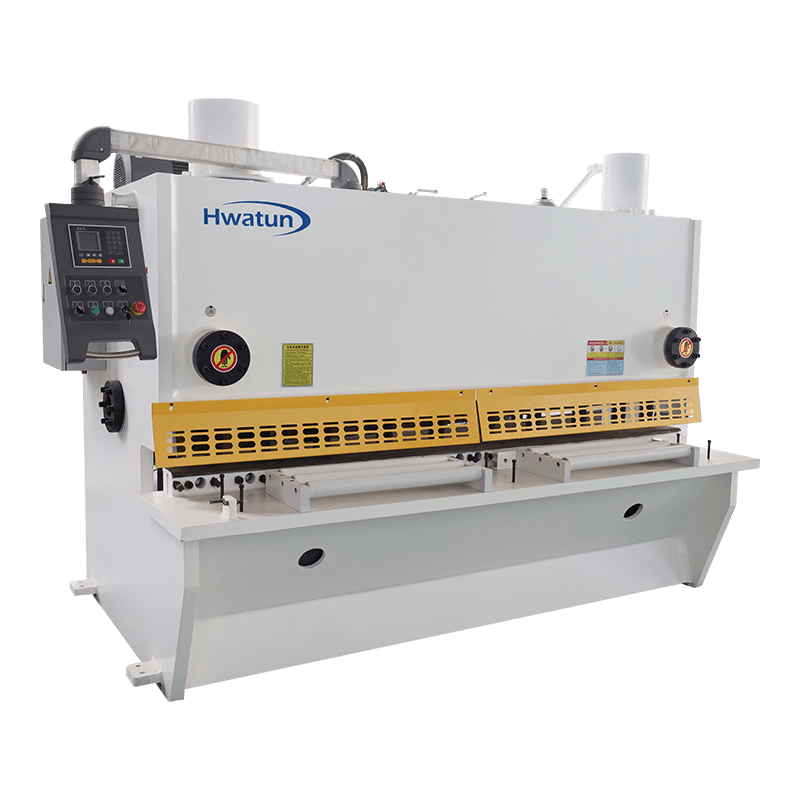Web Menu
Product Search
Exit Menu
How to maintain the blade and cutting quality of SHEARING MACHINE?
The blade and cutting quality maintenance of the shearing machine are key factors to ensure the long-term efficient operation of the equipment and stable production quality. The performance of the blade directly affects the precision, efficiency and quality of the shearing. The following are some common maintenance methods and precautions:
Inspection and replacement of blades
Regularly check the degree of wear of the blade: As the use time increases, the blade will gradually wear, and severe wear will affect the cutting quality and precision. Therefore, it is necessary to regularly check the sharpness of the blade, the integrity of the blade edge, and whether there are cracks.
Check the gap between the blades: Too large a gap between the blades will lead to incomplete cutting or damage to the blade edge, while too small a gap may cause the material to get stuck and affect the shearing effect. Ensure the reasonable adjustment of the blade gap.
Replace the blade: When the blade is severely worn, damaged or cracked, it needs to be replaced in time. If the blade cannot be repaired, it is recommended to replace it with a new blade to ensure the shearing quality and equipment safety.
Sharpening the blade edge
Regular sharpening: After a period of use, the blade edge will become blunt, and sharpening is required at this time. Grinding can be done with professional sharpening equipment or manual grinding tools, but it is necessary to ensure that the angle and smoothness of the blade after grinding meet the requirements.
Grinding method: When grinding, ensure that the blade edge maintains the correct angle. Too sharp a blade is prone to brittle cracks, while too blunt a blade will cause insufficient shearing force and affect the working effect. During the grinding process, excessive wear should be avoided to avoid reducing the service life of the blade.
Lubrication and cleaning of blades
Regular lubrication: Lubrication of blades is an effective way to reduce wear and avoid overheating. Special lubricating oil should be used for lubrication to reduce friction between the blade and the material, improve shearing efficiency and the service life of the blade. Lubricating oil should be selected according to the actual use environment, and inferior oil should be avoided.

Cleaning the blade: During use, the blade will accumulate impurities such as material residues and oil stains, which may cause increased wear on the blade surface. Cleaning the blade regularly and removing debris attached to the blade can effectively extend the life of the blade and ensure the shearing effect.
Protective measures for blades
Avoid collision with hard objects: When the blade is not in use, it should be avoided from impact or extrusion to prevent damage to the blade. When storing the blade, avoid contact with other hard objects. You can use a special blade storage box or protective cover.
Prevent corrosion: Blades are prone to corrosion in a humid environment, so you need to keep the blade dry. You can use anti-rust oil or protective coating to protect the blade from moisture and oxidation.
Material and quality selection of blades
Choose high-quality blade materials: The material of the blade directly affects its cutting ability and service life. High-quality blade materials have better wear resistance and fatigue resistance, and can cope with higher-intensity shearing work. Common blade materials include high-speed steel (HSS), carbide and alloy steel. The appropriate material should be selected according to the hardness and working conditions of the shearing material.
Heat treatment of blade materials: The heat treatment process of the blade will affect its hardness and wear resistance. Reasonable heat treatment can increase the hardness of the blade, thereby enhancing the service life and shearing accuracy of the blade. During the heat treatment process, ensure uniform heating and cooling to avoid deformation or cracks of the blade.
Precise adjustment of blades
Adjust the gap between the blades: The gap between the blades has an important influence on the shearing effect. If the gap is too small, it is easy to cause excessive wear of the blade. If the gap is too large, it will cause unclean cutting and affect the cutting quality. Therefore, the gap of the blade should be adjusted accurately, usually according to the thickness and hardness of the material.
Precisely align the blade: The blade must be accurately aligned when it is installed. Inaccurate alignment of the blade will cause misalignment during the cutting process, and even cause the blade to collide during operation, affecting the shearing quality and accelerating wear.
Use the correct operating procedures
Avoid overloading: When the shearing machine is running, overloading should be avoided. Overloading will cause excessive shearing force on the blade, which will accelerate blade wear or damage.
Uniform load: When using the shearing machine, ensure that the material is fed evenly and avoid excessive local load, which can reduce blade wear and ensure cutting quality.
Regular inspection and maintenance: In addition to the maintenance of the blade itself, other parts of the shearing machine (such as the hydraulic system, electrical control system, etc.) should also be regularly inspected and maintained to ensure that the overall equipment is in good operation, thereby extending the service life of the blade.
Through the above methods, the blade and cutting quality of the shearing machine can be effectively maintained and optimized, thereby improving production efficiency, reducing failure rate, and ensuring the quality of the final product.
News categories
Product categories
Related Products
 +86-159 5138 1316
+86-159 5138 1316 +86 180 6819 3096
+86 180 6819 3096 [email protected]
[email protected] Group 4, Xinba Village, Binhai New Area (jiaoxie Town), Laoba Port, Nantong City, Jiangsu, China.
Group 4, Xinba Village, Binhai New Area (jiaoxie Town), Laoba Port, Nantong City, Jiangsu, China.
Copyright © Nantong Hwatun Heavy Machine Tool Co., Ltd. All Rights Reserved.

 Eng
Eng  简体中文
简体中文 Español
Español русский
русский







